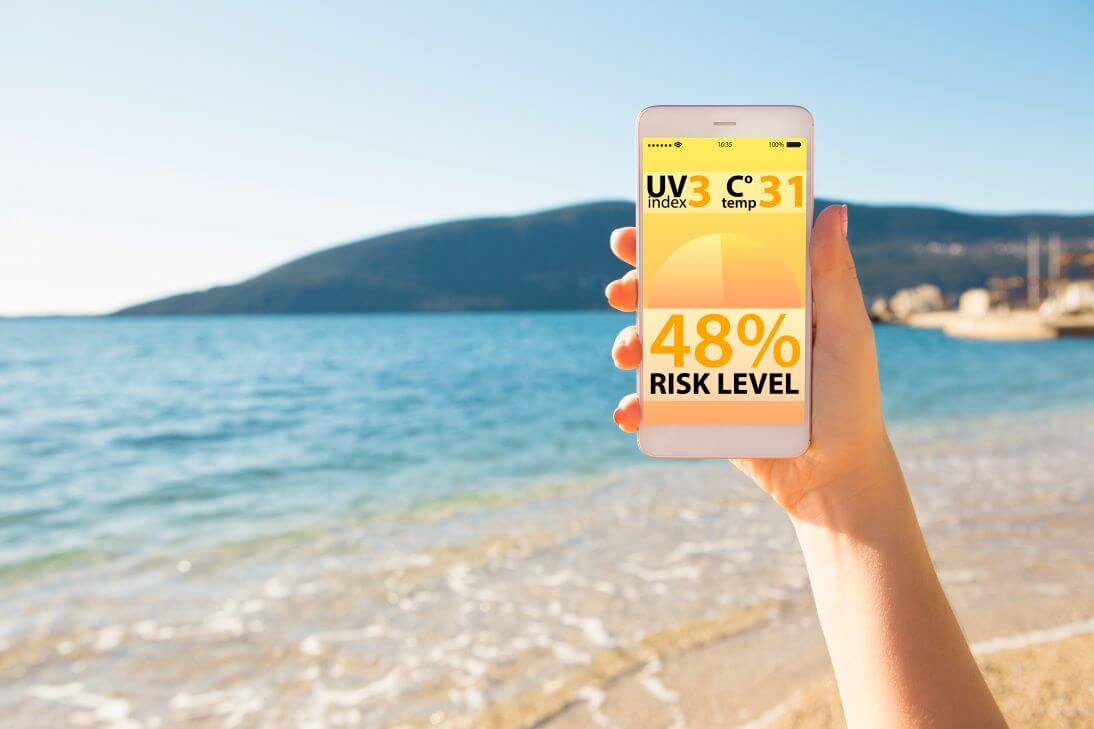Many of us see UV index alerts on our phones or televisions, but few people truly understand what these alerts mean. According to Dr. Drew Reese of U.S. Dermatology Partners Goodyear, Arizona, “People believe numerous inaccurate things about UV alerts from thinking these alerts indicate a change in temperature to believing a low UV index means it’s absolutely safe to have extended sun exposure. It’s important to truly understand what UV alerts mean, so you can take the appropriate steps to protect yourself and your family.” In this blog, Dr. Reese walks through what UV index alerts mean, how they impact skin health, and how you can keep yourself safe.
Understanding the UV Index: What Does it Mean for You?
The UV index has been around for a long time, but in recent years, UV alerts have been pushed out by weather apps on our phones, smartwatches, and other devices. Many businesses even push out alerts over intranet networks to ensure employees are aware of potential risks. While more people see UV index alerts, there is very little information included in these alerts. In order to protect yourself from potential UV skin damage, you have to better understand what the UV index means. According to Dr. Reese, “Getting UV alerts on your phone can only take you so far if you don’t know what they mean. Bottom line, the UV index tells you how likely you are to get a sunburn. The damaging effects of sun exposure are cumulative, meaning the more sunburns you get, the greater your risk for skin cancer and other long-term side effects of sun damage in addition to the short-term effects. The UV index can help you know your risk for sunburn and take appropriate steps to protect your skin now and in the future.”
The Science Behind UV Radiation and Its Effects on Skin
When it comes to understanding UV radiation, Dr. Reese says, “The sun’s ultraviolet (UV) rays cause a form of free radical damage. Other forms of free radical damage include rusting metals, copper turning green, and fruit rotting. Free radicals develop within the human body as part of the natural metabolism processes. They can also develop after exposure to UV radiation, pollutants, and other sources. While free radicals don’t last for long, they can cause significant DNA damage, leading to premature skin aging, sunburns, and even skin cancer.”
There are three types of UV radiation produced by the sun:
- UVA – This form of UV radiation was once considered safe. Today, we understand that UVA doesn’t cause immediate skin damage like sunburns, but it is a major contributor to long-term effects like fine lines, wrinkles, tanned or leathered skin and skin cancer. Additionally, this form of UV radiation easily penetrates the clouds, windows, and windshields that can diffuse UVB radiation. Remember A is for aging.
- UVB – This is the type of UV radiation most people think of. It causes sunburns as well as suntans. It can also contribute to long-term effects. Specifically, UVB radiation is one of the main causes of basal cell carcinoma, squamous cell carcinoma, and melanoma. Remember B is for burns.
- UVC – This form of UV radiation is the most dangerous, but luckily, it is absorbed in the upper atmosphere before reaching the earth.
How to Interpret UV Index Alerts
The UV Index Scale used in the United States conforms with international guidelines for UVI reporting established by the World Health Organization. Learning how to read the UV index Scale can help you protect yourself from harmful exposure to UV radiation. Next time you get a UV index alert on your phone, refer to the scale below to determine your risk:
- UV Index 0-2 – a very low risk of UV-related skin damage. Most people can safely be in the sun without any damage. Those with sensitive or very light skin, infants, and children should still be cautious.
- UV Index 3-5 – still a low risk for skin damage related to sun exposure. However, those with pale skin may experience sunburn after half an hour or less of sun exposure. Sunscreen use is recommended to protect the skin.
- UV Index 6-7 – moderate risk of skin damage related to UV exposure. Those with fair skin are likely to burn within thirty minutes of sun exposure. Everyone should take steps to minimize sun exposure, especially during peak hours. Protect skin by applying sunscreen and taking breaks during prolonged sun exposure.
- UV Index 8-10 – high risk of sun-related UV damage. Fair-skinned people will likely develop sunburn within fifteen minutes of exposure. All skin types should avoid sun exposure during peak hours, apply and reapply sunscreen, and take regular breaks during prolonged sun exposure.
- UV Index 11+ – very high risk of UV skin damage. Fair-skinned people will likely burn in under five minutes of sun exposure. Minimal time should be spent outside. If you need to be outdoors, wear protective clothing, apply and reapply sunscreen, and seek shade regularly.
Practical Tips for UV Protection and Skin Cancer Prevention
Keeping skin safe from the sun means taking steps to prevent UV damage. Your dermatologist can walk you through a personalized UV protection routine, but some of the most important steps include:
- Wear sunscreen – You should be applying sunscreen every day to any areas of the skin that are exposed to sunlight. You should reapply periodically (at least every two hours) throughout the day. Choose a broad-spectrum sunscreen to protect against both UVA and UVB rays with an SPF of 30 or higher. Colorscience Total Protection No Show Mineral Sunscreen SPF 50 is a great option.
- Choose sun-protective clothing – Long sleeves, gloves, hats, sunglasses, and other protective clothing should be worn to block the sun’s rays. There are even clothes made from fabrics specially designed to protect against UV rays.
- Take breaks – Seek shade or go indoors periodically to give skin a rest from UV radiation.
- Plan outdoor activities wisely – Avoid sun exposure during peak hours between 10 am and 4 pm. Plan early morning and evening activities instead. If you do need to be outdoors during these times, stay in the shade and follow the other recommendations above.
Recognizing and Responding to Signs of Skin Damage
Sun damage takes many forms. From suntans to burns to wrinkles, fine lines, and age spots, the sun is responsible for a range of skin health concerns. However, skin cancer is by far the most serious form of sun-related skin damage. It’s important to recognize and address sun-related skin health issues as they arise, especially if you notice any of the common warning signs of skin cancer. According to Dr. Reese, “It’s easy to remember the most common symptoms of skin cancer. You just have to know your ABCDEs. A is for asymmetry. When examining your skin, do you notice any lesions that appear different on one side? B is for border. Does the border of the lesion or spot appear scalloped or jagged? C is for color. Is the color of the lesion abnormal compared to other spots or are there multiple colors within one lesion? D is for diameter. Is the spot larger in size than a standard pencil eraser? E is for evolution. Is the spot changing or growing quickly? If you answer yes to any of these questions related to a new or changing spot on your skin, contact a dermatologist right away to schedule a skin cancer exam.”
Becoming UV-Savvy: Prioritize Your Skin Health
When it comes to being UV-savvy, Dr. Reese says, “First and foremost, make sure you’re wearing sunscreen every day. The best preventive measure you can take against sun damage is to protect all skin exposed to sunlight. If UV alerts come through, keep sunscreen on hand to reapply before heading outdoors. Daily sun protection and proactive sunscreen reapplication after UV index alerts will significantly reduce your risk for skin cancer.”
Schedule an Annual Skin Cancer Screening
If you’re interested in learning more about UV alerts, skin cancer risk, or skin health in general, don’t hesitate to reach out to a local U.S. Dermatology Partners office. Every adult should visit a dermatologist at least once a year for a skin cancer screening. To get started working with one of our skilled dermatologists, simply take a few moments to complete our online scheduling request form. Once we hear from you, we’ll be in touch to finalize the details of your visit. Have friends or loved ones who need to know more about UV Alerts and skin cancer risks? Please share this informational resource to help them stay informed.
Find a location near me
or


